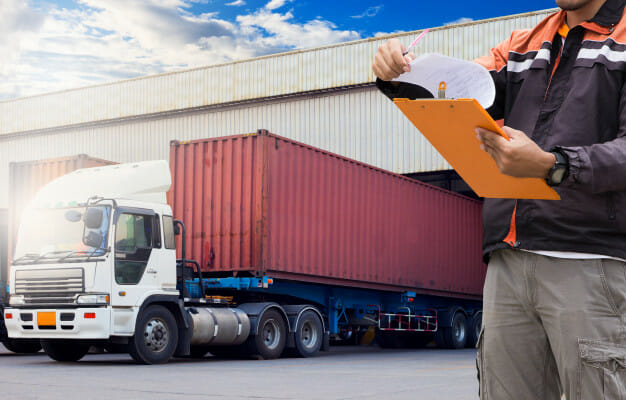5 AI Solutions for the Logistics Sector

In an era of infinite possibilities, new innovations are reshaping economic, social, and cultural environments.
Of all emerging technologies, perhaps none is as disruptive as artificial intelligence.
It’s still in its infancy, yet its widespread applications are changing many industries.
Logistics is no exception.
The sector has always been plagued with inefficiencies.
From supply chains to transportation, AI is changing the way consumer products move around the world.
Here, you can explore current and future possibilities of artificial intelligence in the logistics sector.
Rising AI Solutions in Logistics
Often, manufacturers experience bottlenecks in production or delays in transportation.
These result in extended lead times.
Due to these inefficiencies, manufacturers end up with dissatisfied customers.
Defects in the production process are more devastating. Aside from material loss, companies’ productivity suffers.
Mistakes in inventory forecasting might not be as distressing, but it’s still a problem that needs fixing.
Artificial intelligence is an ideal solution for all of these inefficiencies. Even senior executives from transportation sectors believe so.
About 65% of 433 senior execs are convinced that AI is going to transform logistics, supply chain, and transportation process.
1. Intelligent, Automated Warehouses
Amazon and other large retailers require fast and complex technology for their everyday operations. As a solution, many are adopting automated warehouses where artificial intelligence and robotics are slowly substituting human tasks.Take Amazon warehouses for example. On the warehouse floors, they’ve laid out a series of computerized barcode stickers which enable robots to move around the area.
Each unit is equipped with a sensor that prevents it from colliding with other robots while carrying goods from point A to point B.
Warehouse robots can move an entire pod—stacked with consumer goods—to the human operator, who is tasked to pick orders.
The benefit to this is the faster processing of consumer goods, which specifically:
- Simplifies the order fulfillment
- Minimizes errors around the picking of orders
- Accelerates picking and packing of orders
Amazon, after a warehouse test run, has set up machines that can work on 700 orders per hour. This is five times more than the speed of human workers.
Another company that’s taking advantage of artificial intelligence is England-based online grocer Ocado.
Their robots can fulfill around 65,000 orders within a week, which is about 3.5 million grocery products.
Aside from this, Ocado’s robots can also sort the inventory.
2. Smart Roads
AI is now being used to build smart roads.Colorado, for example, intends to equip highways with sensors and monitors to keep track of passing cars and road damage. Like any smart device, these roads can connect to the internet.
Smart roads can also increase driver and passenger safety. Whether it’s an accident or a traffic jam, motorists can receive phone notifications, allowing them to choose the safer and most efficient route.
Also, road monitoring technologies will be valuable for businesses who need to get consumer goods from point A to point B efficiently.
This technology is beneficial to everyday commuters and companies alike:
- Gives insights on situations that can delay orders
- Predicts traffic jams before they happen
- Helps retailers avoid congested areas
- Advises on alternative routes for timely order delivery
Smart roads can reduce lapses in order delivery. Delays in transportation have a significant impact on businesses, so much so that a 10-30% effectiveness in commodity shipping can save 100-300 billion in the European logistics industry.
3. Predictive Capacity Planning
One of the most underutilized assets in the logistics sector is the massive volumes of data that supply chains generate on a daily basis. A human workforce alone wouldn’t be able to sift through all that information and make sense of it. But AI and machine learning can.
Here are some of the changes that AI has brought to logistics management:
-
Predicting fluctuations in demand
Predicting changes in demand used to be so challenging for companies because of a number of factors, including sales numbers, weather conditions, and consumer attributes.
Now, companies can accurately forecast fluctuations by looking into all of the factors that influence demand.
Then, they can use that information to make the necessary adjustments to their operations in real-time.
These accurate forecasts come in handy for many industries, even in critical situations like supplying blood.
NHS, a UK health service provider, used planning algorithms to analyze hospitals’ blood shelf life, transportation method, supply and demand per blood type, and upsurge in blood demand.
They used the results to avoid blood supply shortages.
Their partner hospitals declared a decrease in operation costs, having 30% reduced wastes and 20% reduced costs.

-
Determining potential issues and mitigating risks
New customer demands like urgent deliveries, ad-hoc pickups, as well as time-slot deliveries are creating more challenges for logistics operators. DHL came up with a solution using AI methods.
They use routing algorithms which can analyze social media data, satellite maps, traffic patterns, and more to help operators and drivers deliver consumer goods safely.
The company also uses a cloud-based platform called Resilience 360 which can monitor about 8 million posts from over 300,000 social media sources, allowing companies to identify the risk factors and take action to prevent disruption.

-
Improve network monitoring
Instead of relying on guesswork, DHL deploys machine learning models in certain areas of the company to determine potential delays in air freight.
Their machine learning model can predict the time of day and day of the week that delays are most likely to happen, as well as the carrier that’s going to experience delays.
It can also recognize multiple factors that may affect shipping, such as weather conditions and operational variables.
AI can crunch numbers faster and more accurately than any tool, allowing companies to plan ahead, maximize their resources, mitigate risks, and create ideal solutions.
4. Autonomous vehicles
Driverless trucks might not be coming out anytime soon, but semi-autonomous vehicles are on the rise.An early example is Otto, a startup bought by Uber, which delivered 50,000 Budweiser cans using a self-driving vehicle.
With smart roads, autonomous vehicles will be safer and more efficient for the logistics sector’s operations.
Today, companies use autonomous driving systems.
They travel in a driving formation, following a lead truck with a human driver.
They synchronize braking, accelerating, and steering, which enables them to enhance freight capacity and minimize costs.
5. Computer vision
Soil in itself does not always provide the best nutrition for crops, and farmers regularly have to rotate fields. In the past, manure was used as the main fertilizer for plants, however the modern age has brought a plethora of new and innovative fertilizing solutions.IBM Watson, for instance, uses AI to inspect their physical assets and determine ones that need maintenance. Not only can computer vision identify damages, but it can also classify the type of damage and determine the best solution to repair the assets.
IBM trained their AI vision to identify damages to their train wagons. They installed cameras along the tracks, collecting images of the wagons. The tool’s visual recognition capabilities is now 90% accurate, leading to better equipment maintenance.
Automating logistical work process will improve a company’s use of resources, allowing them to lower costs, minimize risks, and enhance profitability.
In the years to come, businesses who’ve implemented AI solutions will thrive, and those that don’t will be overshadowed by the competition.
Don’t wait for the global supply chain to become more complex and unmanageable.
Adopt scalable AI solutions that can help you navigate the ever-evolving landscape of business.
